You have been referred to the falls prevention home exercise programme by your GP, care home manager or hospital ward physiotherapist.
| My name | |
| Date started | |
| My volunteer's name |
About the falls prevention home exercise programme
Regular strength and balance exercises can improve your physical wellbeing and reduce your risk of falling.
The falls prevention home exercise programme is:
- an 8 week programme which focuses on strength and balance
- designed by the Kingston Hospital physiotherapy team
- administered by Kingston Hospital volunteers. They visit you in your home or care home and help you to complete the exercises.
Who can use the programme
To use the service, you must be referred (you cannot self-refer).
- Kingston Hospital inpatients can be referred by the physiotherapist on their ward.
- Outpatients can be referred by their GP or care home manager.
Aims
The programme aims to:
- reduce your risk of falls and improve your strength, balance and co-ordination
- improve your confidence and mood
- support your wellbeing and independence
- reduce your risk of being admitted to hospital.
Getting started
Once you are enrolled, a member of the Kingston Hospital volunteer team will contact you.
They will allocate a volunteer to visit you in your home or care home and help you complete the exercises.
How to get the best results
To get the best results from the programme:
- For over 65 year olds, the recommended guideline is for at least 150 minutes (2.5 hours) of moderate activity a week.
- Once a week, try to complete the booklet with your allocated community exercise volunteer. Do this for the full 8 weeks of the programme.
- Take part in a weekly phone call with your allocated volunteer. Do this for the first 4 weeks of the programme.
Staying safe during exercise
These exercises are designed to make it safe for you to move your body and get the most benefit from exercising. Follow the exercises as designed by our physiotherapists and guided by the volunteer who is supporting you.
To stay safe during exercise, do the following:
- Warm up before you exercise (see Warm up exercises section).
- Cool down after you exercise (see Cool down stretches section).
- Exercise by holding on to an object which is sturdy and stable. This can be a heavy chair or table or a kitchen sink.
- Wear comfortable clothes and supportive, non-slip footwear.
- Drink a glass of water before you start the exercises.
- Avoid exercising on an empty stomach.
| If you experience chest pain, dizziness or severe shortness of breath. |
Stop exercising immediately.
|
|
If you experience pain in your joints or muscles |
Stop exercising. Re-read the exercise instructions and check your technique. Try exercising again. Tell your volunteer. |
|
If you have questions about this programme |
 Call the Volunteering Team at Kingston Hospital (see Contacts section). |
Exercise levels
Your physiotherapist has referred you to the service at either the ‘Seated’ or ‘Standing’ level of the programme. See the relevant sections below.
Both levels include increased targets for each exercise if they become too easy for you.
Each time you see your volunteer, you can discuss whether you are finding the exercises too easy or hard.
If you find the exercises too easy, your volunteer may give you an exercise ‘resistance’ band, which you can use to make them a little harder.
Warm up exercises
Use the drop-down menu for instructions on how to do warm up exercises.
Always begin with a warm up of stretching to prepare your body for the main workout.
Ankle circles
- Sit upright in the chair
- Lift one foot out in front of you
- Circle your ankle in one direction and then the other
- Repeat on the other leg
- Keep doing this for 30 seconds.

Leg march
- Sit upright
- Hold the sides of the chair
- Lift your feet one at a time and slowly place them back on the floor
- Do this for alternate legs
- Keep doing this for 30 seconds.
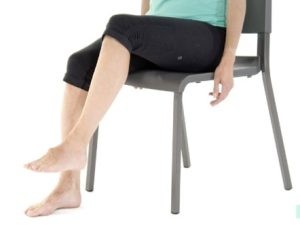
Shoulder circles
- Sit upright in the chair with your arms hanging at your sides
- Lift both shoulders up to your ears, roll them around in a circle
- Repeat slowly 10 times
- Do one shoulder at a time if that feels easier.
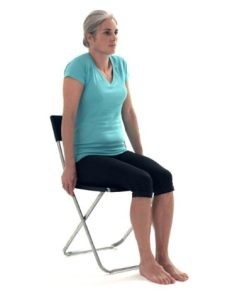
Trunk bends
- Sit upright in your chair with your hands on your knees
- Slide your hands down your legs towards your shins. Slide them as far as feels comfortable for you
- Return your hands to their starting position
- Repeat this 5 times
- If you have osteoporosis, be careful to only perform a small amount of movement. Do not push until you feel pain.
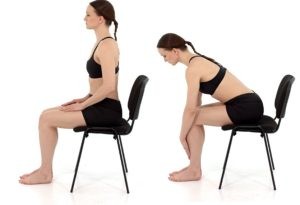
Main exercises
There are lower body, upper body and balance exercises in this booklet.
Each time you use this programme:
- Choose 3 exercises (one from each section). This means one from lower body, one from upper body and one from balance.
- Try to select different exercises each time, so you have done them all by the end of the week.
Physiotherapy top tips
- Breathe naturally. It can be helpful to count your repetitions out loud.
- Maintain good upright posture throughout your exercises.
- It’s best to exercise little and often.
- These exercises are simple enough to add to your daily routine. Try doing seated exercises while you watch TV. Try doing heel raises while you are standing waiting for the kettle to boil.
- We need to use our muscles to strengthen them. To exercise at the correct level of difficulty, you need to just about be able to achieve your target number for each exercise.
- If it feels too easy, it means it is too easy. Try making the exercise harder.
Strength exercises: lower body
Use the drop-down menus for instructions on how to do the lower body strength exercises.
Leg kick out
- Sit upright away from the back of your chair
- Keeping your thighs on the chair, straighten your leg from your knee and hold for 3 seconds
- Return to starting position
- Repeat this, aiming for 10 times
- Repeat with other leg
- To make this exercise harder, add in a resistance band.
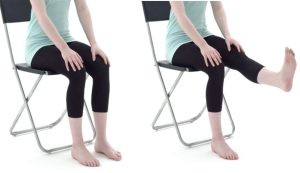
Seated heel raise
Goal: to support good movement in your ankles for easier walking.
- Sit upright away from the back of your chair
- Put both feet on the floor to start. Lift your heels off the floor and up onto your toes. Hold for 3 seconds. Slowly put your heels back to the floor
- Repeat this, aiming for 10 times
- To make this exercise harder, add a weighted object to your knees and hold it there (for example a book or hand weight).
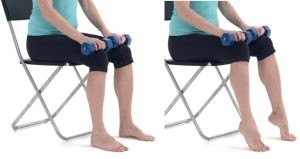
Seated toe lifts
Goal: to support good movement in your ankles for easier walking.
- Sit upright away from the back of your chair
- Put both feet on the floor to start. Lift your toes off the floor while keeping your heels on the floor. Hold for 3 seconds. Slowly put your toes back to the floor
- Repeat this, aiming for 10 times.
- To make this exercise harder, add a weighted object to your knees and hold it there (for example a book or hand weight).
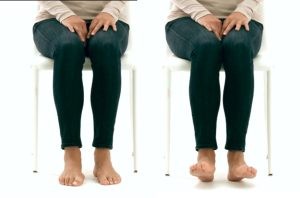
Knee openers
Goal: to make it easier to get in and out of bed or a car.
- Sit upright away from the back of your chair.
- Start with your feet and knees together. Take one leg out to the side, away from the other knee. Return to start position
- Repeat this, aiming for 10 times
- Switch to the opposite leg
- To make this exercise harder, add in a resistance band.
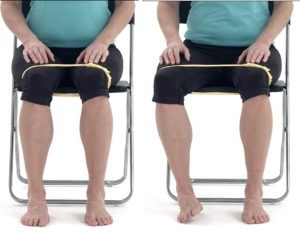
Heel slides
Goal: to make it easier to stand and pick up objects from the floor.
- Sit upright away from the back of your chair.
- Extend one leg straight out in front of you
- Keeping your heel on the floor, slide your foot back as far as you can
- Return to the starting position
- Repeat this, aiming for 10 times
- Switch to the opposite leg
- To make this exercise harder, add in a resistance band.
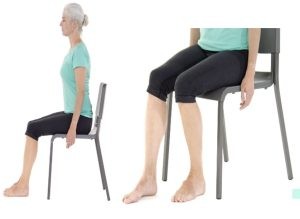
Sit to stand
Goal: to make it easier to get out of bed or out of your chair.
- Sit upright and near the front of your chair
- Place your feet slightly behind your knees and lean forwards
- Stand up tall (with minimal use of your arms) then slowly sit back down
- Aim to repeat this 10 times
- To make this exercise harder, do it without using your arms.
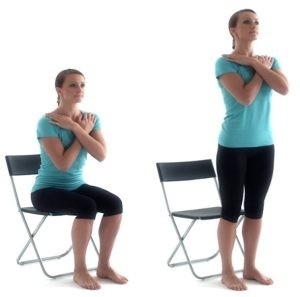
Heel raises
Goal: to support good movement in your ankles for easier walking.
- Sit upright holding onto a sturdy support (if unsteady, hold on with both hands)
- Raise your heels coming up onto your tip toes
- Slowly lower your heels back down
- Aim to complete 10 times
- To make this exercise harder, single leg heel raises or one-hand assistance.
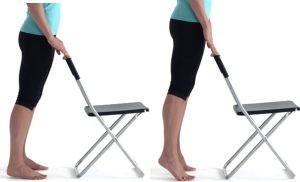
Toe lifts
Goal: to support good movement in your ankles for easier walking.
- Stand upright holding onto a sturdy support (if you feel unsteady, hold on with both hands)
- Raise your toes, coming up onto your heels
- Slowly lower your toes back down
- Aim to complete 10 times
- To make this exercise harder, use one-hand assistance
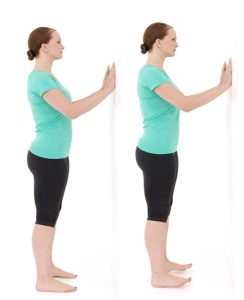
Hip side kick
Goal: to make it easier to get in and out of bed or a car.
- Stand upright and hold onto a sturdy support (if unsteady, hold on with both hands)
- Take one leg slowly out to the side, keeping your body upright
- Keep your toes facing forward
- Return to starting position
- Complete this 10 times
- Repeat on the other leg
- To make this exercise harder, add in a resistance band around your thighs.
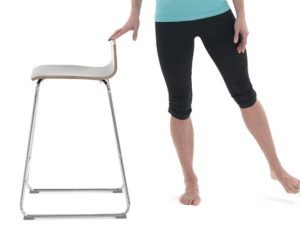
Hip kick back
Goal: to make it easier to pick up objects from the floor, stand upright and walk for longer periods of time.
- Stand upright and hold onto a sturdy support (if unsteady, hold on with both hands)
- Raise one leg backwards as far as you can comfortably. Keep your body upright.
- Keep your foot off the floor and return to starting position.
Avoid leaning forward and arching your lower back. - Aim to complete 10 of these
- Repeat on the other leg
- To make this exercise harder, add in a resistance band around your thighs.
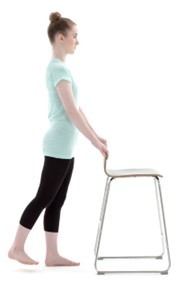
Standing leg curls
Goal: to make it easier to stand and pick up objects from the floor.
- Stand upright and hold onto a sturdy support (if unsteady, hold on with both hands)
- Choose one leg and bend your knee so your heel travels towards your bottom
- Slowly lower your leg back to the starting position
- Aim to complete 10 times
- Repeat on the other leg
- To make this exercise harder, add in a resistance band.
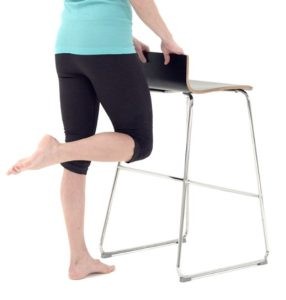
Strength exercises: upper body
Use the drop-down menus for instructions on how to do the upper body strength exercises.
Shoulder press
Goal: to make it easier to reach for things in a cupboard above shoulder level.
- Sit upright away from the back of your chair
- Take your arms out to the side and press your hands together above your head
- Return slowly to starting position
- Aim to complete 10 of these
- To make this exercise harder, add in a resistance band or hold onto a light object in each hand (for example a small bottle of water).
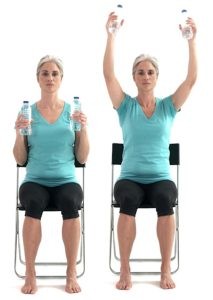
Towel ringing
Goal: to make it easier to open jars and hold onto your shopping bags or household objects.
- Sit upright away from the back of your chair
- Bend your elbows at your sides
- Grip the towel firmly with both hands and twist the towel slowly as if you are wringing water from it
- Wring again in the opposite direction
- Aim to complete 10 of these
- To make this exercise harder, stand and complete the exercise for a balance component.
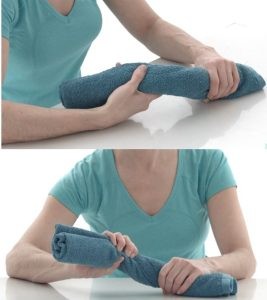
Wall press
Goal: to make it easier to push up from lying in bed or out of your chair.
- Place hands on the wall at chest height with fixed elbows
- Take a small step back and make sure your feet are hip width apart
- Keeping your back straight, bend your elbows so that you move your head and chest towards the wall
- Push up against the wall while straightening your elbows
- Aim to complete 10 of these
- To make this exercise harder, take another small step back.
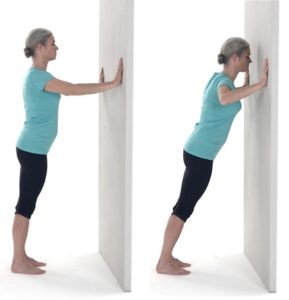
Shoulder press
Goal: to make it easier to reach for things in a cupboard above shoulder level.
- Stand upright
- Raise one arm up above your head
- Return slowly to starting position
- Aim to complete 10 of these on each arm
- To make this exercise harder, hold a light object in each hand (for example a small water bottle).

Core exercises (seated or standing)
This exercise can be completed while sitting or standing.
Lateral leans
Goal: to make it easier to support yourself sitting up in bed and reaching for items that are lower than your hips.
- Sit upright away from the back of your chair or stand tall
- Choose a side to start. Take your hand and trunk down towards the floor on your chosen side, keeping your hips still
- Only go as far as you can. If you are standing, you might only go as far as your knee
- Slowly return to start position
- Complete this 10 times
- To make this exercise harder: hold a light object in your hand (for example a water bottle). This object can start light (empty) then progress (full bottle).
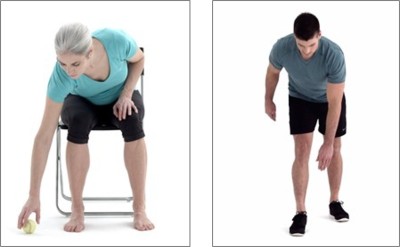
Balance exercises
Use the drop-down menus for instructions on how to do the balance exercises.
Side steps assisted
- Stand upright and hold onto a stable surface such as table or work surface or sink
- Step to the side with a small bend in the knee
- Step back to the centre
- Repeat on the other side
- Aim for 12 steps and repeat 3 times
- To make this exercise harder, hold on with one hand or unassisted.

Single leg stand assisted
- Stand upright holding onto a sturdy support with both hands
- Shift your weight onto one leg
- Raise the other leg by bending the knee and hold for 10 seconds
- Complete this 3 times per leg
- To make this exercise harder, do it unassisted.
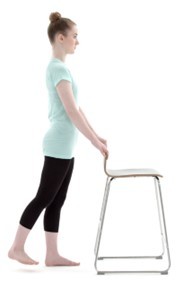
Marching assisted
- Stand upright holding onto a sturdy support with both hands
- March on the sport with alternate legs, lifting your feet off the ground
- Aim to do this for 1 minute
- To make this exercise harder, do it unassisted and slow the movement down to test your balance.

Tandem stand
- Stand upright and hold onto a surface with the other hand at your side
- Place one foot in front of the other as if you are standing on a tightrope
- Hold the position for 20 seconds
- Swap legs
- To make this exercise harder, remove hand assistance, progress to dynamic tandem walk.
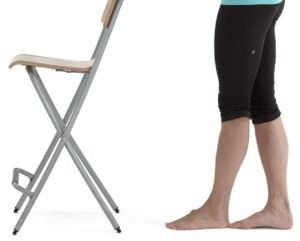
Single leg balance with clock point touches
- Stand on one leg while holding onto a sturdy object for support
- With the other leg, tap out in front and to the side and behind you. You will feel as though you are tapping out the 12, 3 and 6 on a clock
- Complete 5 sets of taps
- Do the same with your other leg
- To make this exercise harder, do it unassisted.
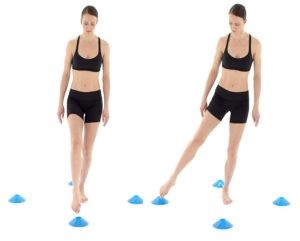
Grapevine walking
- Start by holding onto a surface
- Step to the side
- Move one leg in front or behind the other leg
- Repeat
- To make this exercise harder, do it unassisted.
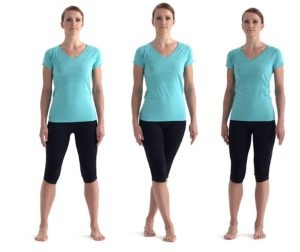
Cool down stretches
You may experience some muscle soreness following exercise. This will probably settle down in a few days.
Some soreness is to be expected while your muscles learn to adapt to the exercises. Soreness or aching does not mean you have an injury.
If you do some stretches as part of your cool down, this can help lower your heart rate. It can also reduce your risk of injury.
You can choose to do these cool down stretches seated if you require a walking aid (for example a stick or frame), or you can do them standing.
Top tip
Make sure you breathe naturally during all these stretches. Do not hold your breath.
Use the drop-down menu for instructions on how to do the cooling down stretches.
Opening up your chest
- Sit upright away from the back of your chair
- Straighten your arms and take them back behind you
- Take them to where you feel a stretch, but do not feel pain
- Hold for 20 seconds.
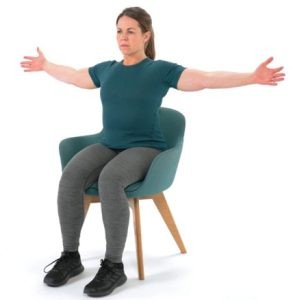
Shoulder cross body
- Sit upright away from the back of your chair
- Wrap one arm around your body
- Use the other hand to push the arm gently above or below your elbow
- Hold for 20 seconds
- Repeat on the other side.
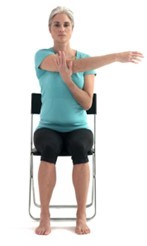
Trunk stretch
- Sit upright and away from the back of your chair, with arms folded across your chest
- Rotate your upper body to one side while keeping your hips in the starting position
- Keep your head in line with the way your body is moving
- Hold for 15 to 20 seconds
- Repeat on the other side
- If you have osteoporosis, be careful to only perform a small amount of movement. Do not push until you feel pain.
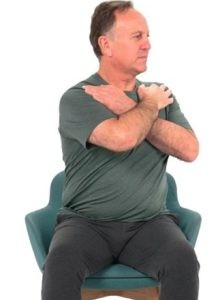
Lower leg stretch
- Stand behind the chair, holding onto the back of it
- Step back with one leg, while keeping both feet pointing forwards
- Press your back heel into the floor until you feel a stretch in your lower leg
- Hold for 20 seconds
- Repeat on the other side.
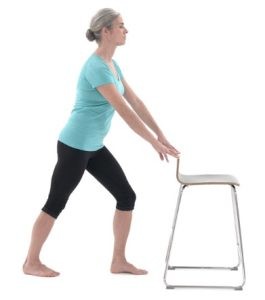
All images used courtesy of Physitrack PLC
Contact information
Kingston Hospital Falls Prevention Volunteering Team
Telephone: